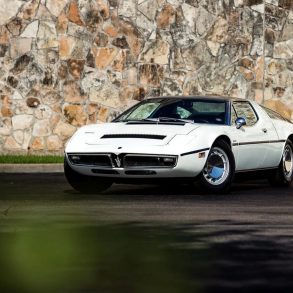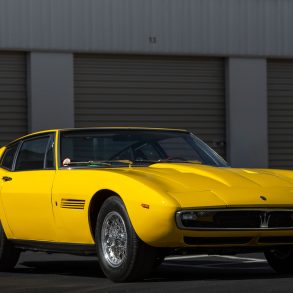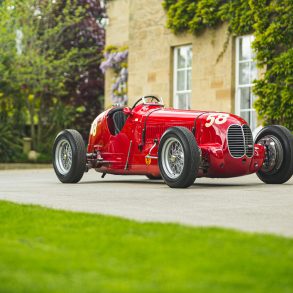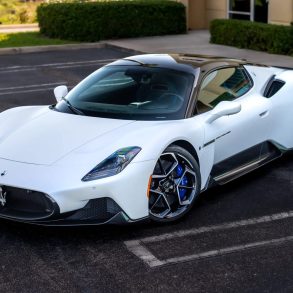Overview of the Maserati Birdcage
The Italian Big Three of Ferrari, Lamborghini, and Maserati are responsible for numerous advancements in the world of performance cars. While Ferrari is a perfect all-rounder everpresent in every era and type of adrenaline-inducing sport available, Lamborghini gave birth to the modern supercar and that leaves us at Maserati.
The oldest of the three had a rich and often troubled history but also had a number of memorable cars. One of them is commonly known as the Maserati Birdcage, although its official names are Maserati Tipo 60 and Tipo 61.
In its short racing career, these two cars revolutionized sports cars and their impact on motorsport is immeasurable. Today, we’ll take an in-depth look into this duo and uncover what made them so extraordinary and memorable to this day.

Background
From today’s perspective, it’s hard to imagine Maserati anything other than a manufacturer of grand tourers with close ties to Ferrari, but more than half a century ago, the two companies couldn’t be further apart.
While Ferrari is primarily known both for its racing prowess and roadgoing V12-powered grand tourers, Maserati was way more focused on motorsports and lighter, more nimble machinery. From its founding in 1926 by the Maserati brothers: Alfieri, Carlo, Bindo, Mario, Ettore, and Ernesto, to the post-WW2 revival in 1946 with the A6 series, Maserati was exclusively a race car manufacturer.

The Maserati brothers were educated engineers and keen racers, so motorsports were the only way to go, and when Alfieri Maserati unexpectedly passed in 1932, the brothers kept the company rolling, eventually selling it to Adolfo Orsi, but keeping involved in the technical side of the business.
Even before World War 2, Maserati was a well-established name in this grassroots sport. The Neptune’s trident was keeping up even with overpowered Mercedes-Benz and Auto Union Grand Prix cars, and to this day, Maserati has been the only Italian brand to win the Indianapolis 500, scoring victories in 1939 and 1940.

Soon after World War 2 ended and twenty years after its first race car saw the light of day, Maserati launched the A6 Series of roadgoing sports cars in 1946. However, as expected, the A6 also marked Maserati’s return to racing in post-WW2 Europe too.
Luckily for Maserati, Adolfo Orsi had an engineering ace Giulio Alfieri under his wing. Maserati’s technical director came to Modena in 1953, alongside Vittorio Bellentani and Gioacchino Colombo, the creator of Ferrari’s V12.
The trio worked on both the A6 Series and the 250F Grand Prix car and while Bellentani and Colombo soon left Maserati, it was Maserati engineer Giulio Alfieri that continued developing race cars for the company.

Maserati reached its pinnacle with the 250F, a Grand Prix racer piloted by none other than Juan Manuel Fangio. The Argentinian ace first sat in a 250F in 1954 Formula One season, winning two races before departing to Mercedes-Benz where he ended up the 1954 champion. Fangio returned to the 250F in 1957 and had scored four victories, he was crowned Formula One World Champion for the final time in his career.
In addition to considerable Formula One success, Maserati built and raced sports cars for the increasingly popular World Sports Car Championship, where it campaigned the notorious 450S.

Development
The late 1950s were the times of tectonic changes in motor racing. Due to the advancements of race cars and the rapid motorization of Europe, the era witnessed a number of horrendous accidents on long races on public roads.
The accident that changed Italian road racing happened at the 1957 Mille Miglia, where Alfonso de Portago’s Ferrari 335 S suffered a punctured tire, resulting in a spin that killed ten spectators, five of them children. De Portago and his navigator Edmund Nelson were also tragically killed. In the grim aftermath of the race, the Mille Miglia didn’t see its 1958 edition.
A new era of prototype racing demanded lighter, nimbler, and more maneuverable cars. These changes introduced new designs and construction methods like the monocoque which was quickly adopted by British manufacturers.

Despite stellar racing DNA, Maserati faced financial hardships culminating in 1957 when all three Maserati 450S cars crashed throughout the season. Maserati was already struggling financially, and the 450S was heavy, unreliable, and only good in the straight line, completely unfit for the new challenges of track racing.

To survive, Maserati needed a new car, one radically different from the torpid 450S. Giulio Alfieri realized that lightness was the key to winning, so instead of experimenting with large engines or expensive monocoque designs, he devised a previously unseen lightweight tubular structure.
Tubular space frames weren’t all new in the racing world, as this construction method was used combined with heavy steel ladder frames. On the other hand, Giulio Alfieri’s revolutionary tubular frame design was carried out almost exclusively out of 10 and 15 mm thick short steel tubes (200 of them!).
Upon completion of the first chassis, Stirling Moss extensively tested the cars around the Nürburgring and at the Aeroautodromo in Modena where the initial construction revealed some drawbacks. When put under stress, a large portion of welds showed cracks and fractures due to the high rigidity of the steel used.


The solution to this potentially hazardous issue was counterintuitive, yet simple and highly effective: Alfieri remade the chassis by using softer steel of lesser quality. Even though this proposal faced severe opposition, it proved to be the right move and so the Tipo 60 could retain its low weight without adding more steel reinforcements to the structure.
In July 1959, the car was ready for its official debut at the 7th Grand Prix of Rouen, an event for both Formula 2 and sports cars. Stirling Moss won both events: the first in a Cooper T45 Borgward and the other in the Tipo 60.

The triumphant debut for the Tipo 60 sparked interest from Camoradi USA. The Italian-sounding name actually stood for Casner Motor Racing Division, a Miami-based racing outlet founded by a car dealer and gentleman racer Lloyd ‘Lucky’ Casner who became a patron for Maserati’s Tipo 61, a car sporting a larger engine meant for racing across the Atlantic.
Between 1959 and February 1961, Maserati built a total of six Tipo 60 and 17 Tipo 61 cars, including the first Maserati Tipo 60 prototype converted to Tipo 61 specs.


In 1961, Tipo 60 and 61 got a mid-engined spin-off in the form of the Tipo 63. But, as this car had a considerably different layout and mild success compared to the original Birdcage race cars, we’ll keep it to the Tipo 60/61 pair and see what made those cars so successful on the tracks.
Chassis
Both the Tipo 60 and Tipo 61 race cars were built around a similar lightweight tubular structure consisting of a cleverly engineered skeleton made out of over 200 short chromium-molybdenum steel tubes of different profiles.
Stripped of the bodywork, the intricate steel structure of the Tipo 60 and Tipo 61 resembled a birdcage frame, hence the birdcage nickname that made these cars famous.

To achieve optimal torsional rigidity in a featherweight package, Giulio Alfieri constructed a large number of triangular structures throughout the arrangement, especially in high-stress areas, successfully emulating the properties of a steel panel monocoque.
In its final form, the cage-like frame was as rigid as a monocoque and weighing just 155 lb, it was considerably lighter than a ladder frame, meaning that Giulio Alfieri’s revolutionary idea was perfectly implemented on the Maserati Birdcage Tipo 60 and Tipo 61 birdcage.

Engine and Transmission
For the Tipo 60, the engine was sourced from the Tipo 52 200S prototype, Maserati’s answer to the 500 Mondial, one of the very few four-cylinder Ferraris ever created.
The dual overhead camshaft 2.0-liter straight-four was substantially re-engineered to extract its maximum in the new prototype. The bore and stroke were changed from 92x75mm to 93.8×72, moving the redline higher.

To achieve a lower center of gravity and optimal weight balance, Giulio Alfieri tilted the engine 45°, moving it behind the front axle. This setup also enabled a low-drag aerodynamic profile of the front end of the car, increasing its trackside abilities.
Finally, the cylinder head was reworked, the exhaust shifted to the right side and the Tipo 60 was equipped with twin Marelli ignition. Just like the Tipo 52, the Birdcage had twin Weber 45 DCO3 carburetors, all resulting in 200 horsepower.
For the Tipo 61 to be more competent on North American tracks, the engine was given a significant bump in displacement. Equipped with a 2.9-liter DOHC straight-four, the Tipo 61 had 250 horsepower, but it was also 66 lb heavier due to a need for a bigger driveshaft. Still, thanks to its extremely lightweight and efficient aerodynamics, the Tipo 61 could achieve speeds of around 180 MPH, making it one of the all-around fastest cars of the early 1960s.

For perfectly balanced weight, both the Tipo 60 and Tipo 61 employed a five-speed transaxle with an integrated differential box. This unit was borrowed from the well-proven, championship-winning 250F Grand Prix car and modified to fit the prototype cars.
Body and Interior
Just like the tubular chassis, the lightweight aluminum bodywork of the Tipo 60 and 61 was handbuilt by Allegretti & Gentilini. This outlet was formed in 1958 by ex-Carrozzeria Fantuzzi employee Mario Allegretti and Anselmo Gentilini, while Alllegreti himself worked for Maserati on the A6GS and 250F among other cars.

Being bona fide race cars, these thin aluminum bodies were built with beauty being pushed away in favor of aerodynamic efficiency.
Having tilted the engine, Giulio Alfieri enabled the hood of the Maserati Birdcage to form a low-drag aerodynamic front; in fact, the front central section of the Maserati Tipo 60 and Tipo 61 was so low that it sat noticeably below its bulging fenders.
Both cars had short front and rear overhangs, making them highly maneuverable and having an ideal advantage on demanding twisty circuits.

In addition to regular bodies, Giulio Alfieri developed a new Tipo 61 design exclusively for the 1960 24 Hours of Le Mans. The body was redesigned using a wind tunnel and Alfieri made the alterations to give the Le Mans-only Tipo 61 greater straight-line stability. The new body got a long tail and a sloping windscreen and was referred to as the Tipo 61 Streamliner.

The sports racing car regulations of the era stipulated a windshield of a certain height, which would have compromised the aerodynamic properties of the Birdcage. To keep the airflow minimally interrupted, Giulio Alfieri inclined the windshield backward, exposing a part of the tubular skeleton and creating a design that actually produced minimal wind protection.
In line with the car’s only purpose, the interior of the Maserati Birdcage was modest, free of any unnecessary distractions, insulation, or padding. That being said, parts of construction could be seen from the inside, and the dashboard was a floating aluminum panel welded onto the exposed tubular structure covered by nothing but the inclined windshield.

Thanks to its lightweight skeleton, thin aluminum body, and compact engine, the Tipo 60 Birdcage weighed just around 1260 lb, while the heavier Tipo 61 tipped the scales at 1360 lb.
Suspension and Steering
The Birdcage had an independent front suspension with a De Dion rear axle setup, an amalgam of suspension solutions used on the 250F and the 200SI.
In designing the front suspension for the Birdcage, Alfieri reused coil springs and telescopic dampers from the championship-winning 250F Grand Prix car.

The rear suspension on the other hand was carried over from the 200SI and it was a De Dion rear axle with a single transverse leaf spring.
The steering setup of the Tipo 60 and 61 was modern for its age, with a rack-and-pinion steering box.
Brakes, Wheels, and Tires
The lightweight Birdcage duo had formidable stopping abilities due to modern Girling steel disc brakes on both axles, 13-inch front, and 12-inch rear.

As with many Italian cars of the era, the Birdcage used 15×4.5 inches 72-spoke Borrani wire wheels with a central knock-off hub.
Racing
The Tipo 60 Chass. No. 2451 had a stellar debut as a works car, with Stirling Moss taking the highest podium at Rouen in 1959, finishing in front of two Lotus 15 cars driven by Innes Ireland and Alan Stacey. Soon after, this car was modified to Tipo 61 specification and bought by Casner, alongside three more Maserati factory-built Tipo 61 cars.

The other five units of the Tipo 60 successfully raced in Europe where it dominated the Italian Hillclimb Championship and Italian Circuit Racing Championship. Local aces included Odoardo Govoni, Nino Todaro, and Mennato Boffa.
The Tipo 61 had its debut at 1960 Buenos Aires 1000 Kms where the duo of Masten Gregory and Dan Gurney retired from the lead after suffering a broken gearbox.
The first international victory for the Tipo 61 came soon after, at the 1960 Cuban Grand Prix. The racing car driven by Stirling Moss, being the Camoradi Tipo 61, outpaced Pedro Rodriguez in a NART Ferrari 250 TR59, winning the last ever Cuban Grand Prix.

The racing success of the Tipo 60 and 61 was a blend of phenomenal efforts and mishaps. That being said, Nino Vaccarella and Umberto Maglioli had to retire from the lead due to a punctured fuel tank at the 1960 Targa Florio, while the racing team of Dan Gurney and Sir Stirling Moss won 1960 Nürburgring 1000 km in a Tipo 60 in spite of a broken oil line causing them to lose seconds in the last section of the race.

In 1961, Scuderia Camoradi returned with Casner himself behind the wheel, winning that year’s edition of the race with Masten Gregory.
The Tipo 61 Streamliner developed for the 1960 24 Hours of Le Mans failed to live up to expectations despite one of three cars entered developing a substantial lead.
Neither Masten Gregory and Chuck Daigh nor the other two crews managed to finish the most famous endurance race in the world. One of the cars was intended to be raced by Carroll Shelby and Dan Gurney, but due to a falling out between Shelby and Casner, the latter shared the car with Jim Jeffords.
In the United States, the Tipo 61 was campaigned by Bill Krause, Jim Jeffords, Ken Miles, Jim Hall, Briggs Cunningham and Roger Penske among others. The most successful one though was back-to-back 1961 and 1962 SCCA-winning Tipo 61 driven by Penske and Gus Audrey.

Legacy
After the Tipo 60 and Tipo 61, Maserati produced more race cars using the same construction principle, like the mid-engined Tipo 63, the Tipo 154, and 155. Yet, these offsprings didn’t match the success of the original Birdcage designs.
That being said, the two original Birdcage cars are remembered as one of the highest points of Maserati’s post-war racing efforts. Triumphant results and a star-studded cast of the era’s bravest and most skilled drivers made the Tipo 60 and 61 legendary cars and sought after classics by top tier collectors.

On a grander scale, Maserati Tipo 60 and Tipo 61 didn’t just leave an impact on the company’s history; Giulio Alfieri’s revolutionary design influenced the whole automotive world, as similar tubular spaceframe structures were widely embraced by numerous sports car manufacturers, both for the roads and the race tracks.
Thanks to privateers who bought and campaigned the Tipo 60 and Tipo 61, Maserati was able to survive the early 1960s, after which Orsi focused on reimagining the company as a maker of grand tourers and road-going sports cars. That fact alone makes the Maserati Birdcage one of the most important cars ever to carry the Neptune’s Trident.










Great article. My father Gus Andrey said it was the best balanced race car he ever drove. And he won championships in some wonderful cars including his birdcage # 2455. BTW, Roger did not drive the same car
Nice to see the family name on the Tim Scott photo of the T61, from when it was sold at R&M Auctions in 2013. The 2.9L engine must be the roughest running engine this side of a tractor. Enough to shake your the fillings from your teeth. .
Enjoyed the article. The Tipo 61 was one of my father’s (Walt Hansgen) favorite cars to race. In 1960 he scored 1st’s at Cumberland, Bridgehampton, Roosevelt Raceway, Montgomery, and Thompson driving for Briggs Cunningham. In 1961 he won at VIR, Bridgehampton, Indianapolis Raceway Park, and Road America 500 (co-driving with Augie Pabst, in Tipo 61 & 63’s. The cars nimbleness often allowed it to beat higher powered cars. He also drove Tipo 151’s with less success. My dad had many spirited races with Gus Andrey, a very talented driver.
I always loved these beautiful cars. As a mechanical engineer I appreciated the concept and strength of the space frame design. I ride a 1991 Ducati 851 SuperBike. It has a small tube, ‘trellis’ frame. Same idea as the birdcage. Love the bike, love the car. Thanks for the article!